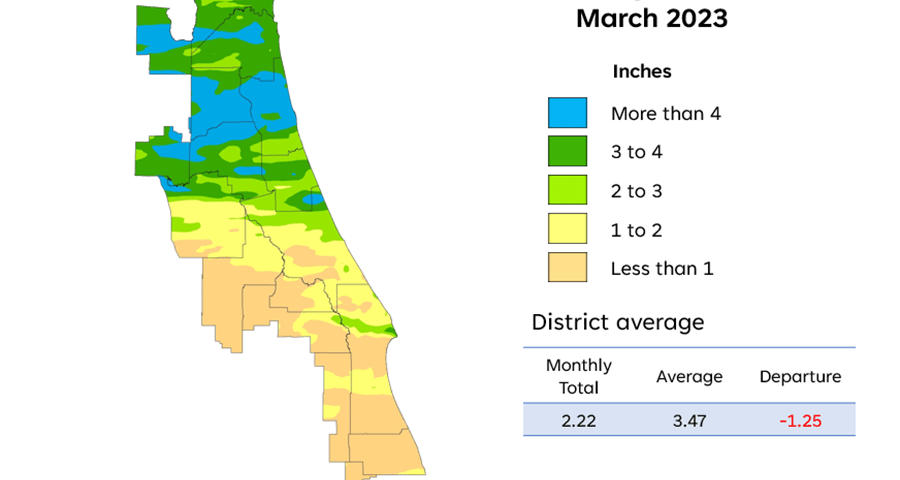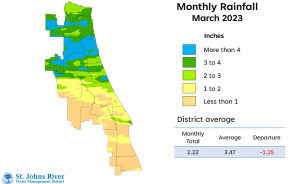Below-average rainfall in March, severe drought conditions begin to develop

A map illustrates rainfall conditions in April across the St. Johns River Water Management District.
PALATKA, Fla., April 12, 2023 — The St. Johns River Water Management District’s 18-county region is experiencing varying degrees of drought conditions according to the U.S. Drought Monitor’s latest report. Rainfall in the northern counties was average to above average last month, while dry conditions continued in the southern counties with seven counties receiving less than one inch of rain in March.

A map illustrates rainfall conditions in March across the St. Johns River Water Management District.
Overall, the District has experienced a relatively low amount of rainfall over the past several months and groundwater levels have declined.
At the end of March, groundwater levels Districtwide are well above drought indicator levels with a majority of the District falling within the normal to high range. District staff will continue to monitor both rainfall amounts and groundwater levels to ensure adequate supply is available to meet public demand.
April is historically one of the direst months of the year and typically marks the peak demand season for public water suppliers, which is why April has been formally recognized as Water Conservation Month for the past 23 years. While it is always critical to use our water wisely, the District strongly encourages the public to be mindful of their water usage during these dry months until our summer rainfall patterns return.
Below are simple tips for residents and businesses to help save hundreds of gallons of water and money on their water bill.
Indoor
- Only run your washing machine and dishwasher when they are full.
- Use the shortest clothes washing cycle for lightly soiled loads; normal and permanent-press wash cycles use more water.
- Thaw frozen food in the refrigerator or microwave, not under running water.
- Scrape, don’t rinse, your dishes before loading in the dishwasher.
- Install high-efficiency showerheads, faucets and toilets.
Outdoor
- Check your home’s irrigation system for leaks.
- Turn off your irrigation system and only water as needed.
- Don’t leave sprinklers unattended. Use a kitchen timer to remind yourself to turn sprinklers off.
- Use a hose with a shut-off nozzle when washing the car.
- Consider installing a rain barrel with a drip irrigation system for watering your landscaping. Rainwater is free and better for your plants because it doesn’t contain hard minerals.
A full report outlining March’s hydrologic conditions was presented at the District’s Governing Board meeting Tuesday. Highlights include:
Rainfall
- Districtwide, March rainfall averaged 2.2 inches, which is 1.25 inches below the average for the month.
- Districtwide, the cumulative rainfall total for the past 12 months is 51.01 inches, which is 1.19 inches below the long-term average.
- There were seven counties with county-wide totals less than one inch: Indian River, portions of Orange, Osceola and Okeechobee, Brevard, Lake and Seminole counties.
Groundwater
- At the end of March, Upper Floridan aquifer conditions (groundwater levels) throughout most of the District were in the normal range.
- Groundwater levels expressed as a single Districtwide index are at the 52nd percentile, which is at the high end of the normal range for this time of year.
Spring flows
- The mean monthly flow at Silver Springs remains in the normal range at 585 cubic feet per second (cfs), or 378 million gallons per day (mgd), which is a 34 cfs decrease from February’s mean.
- At the Blue Spring station in Volusia County, the mean monthly flow was 148 cfs, or 96 mgd, which is in the normal range.
- At Rock Springs, the monthly mean flow remains in the normal range with a decrease of 3 cfs to 61 cfs (39 mgd).
- Mean monthly flow at Wekiwa Springs is in the normal range for this time of year at 70 cfs (45 mgd).
To learn more about rainfall totals and other hydrologic data collected, visit www.sjrwmd.com.
Visit WaterLessFlorida.com for tips to help landscapes thrive while saving water and money. Follow the water conservation conversation at #sjrwmd #waterconservation #savewater.

